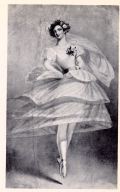Legs: Fetish Objects
 The
sight of a woman’s leg probably was an unusual and exciting
event considering that hemlines up
to and including the nineteenth century were kept conservative,
confined to floating between floor- and ankle-length. That is, of course,
with the exception of dancers. Always shorter
than the skirts of non-dancers, the hemline of the ballerina’s tutu
was raised even higher, hitting the summit of the knee, in the eighteen-forties
(Soloman-Godeau 1986).
The dance critic, Theophile Gautier’s extended
discourse on Elssler's
knee demonstrates
how remarkable the sight of a woman’s lower leg was and how worthy
of
The
sight of a woman’s leg probably was an unusual and exciting
event considering that hemlines up
to and including the nineteenth century were kept conservative,
confined to floating between floor- and ankle-length. That is, of course,
with the exception of dancers. Always shorter
than the skirts of non-dancers, the hemline of the ballerina’s tutu
was raised even higher, hitting the summit of the knee, in the eighteen-forties
(Soloman-Godeau 1986).
The dance critic, Theophile Gautier’s extended
discourse on Elssler's
knee demonstrates
how remarkable the sight of a woman’s lower leg was and how worthy
of  detailed
observation. This fascination with the female leg was even given an element
of the divine, once again conflating the physical and
the spiritual: “She is the priestess of the chaste art;
she prays with her legs” (Lee
1999, p. 155).
detailed
observation. This fascination with the female leg was even given an element
of the divine, once again conflating the physical and
the spiritual: “She is the priestess of the chaste art;
she prays with her legs” (Lee
1999, p. 155).
This fascination for the leg was underscored
and enhanced by the pointe shoe: while hemlines were shortened to increase
the expanse of exposed
leg, the foot rose to the occasion to lengthen its appearance.
When the shoes were coupled with tights of the same colour (usually pink),
the foot of the dancer sur la pointe disappeared, affecting the illusion
of long, continuous legs. The feet and legs that made it possible
to represent the otherworldly
creatures of the Romantic ballet, were
also the site of the fetishistic desire and erotic
titillation of the male spectator.